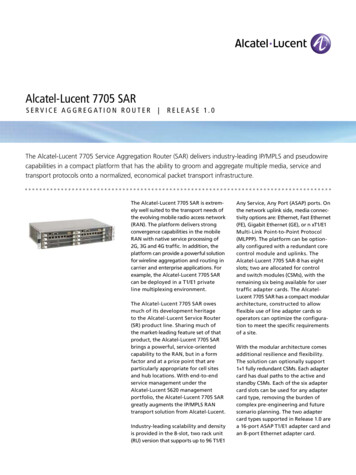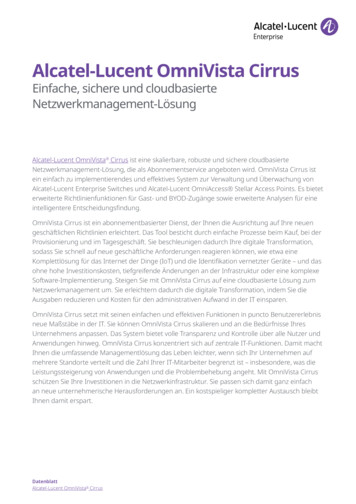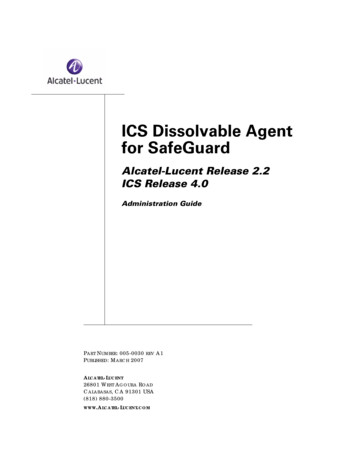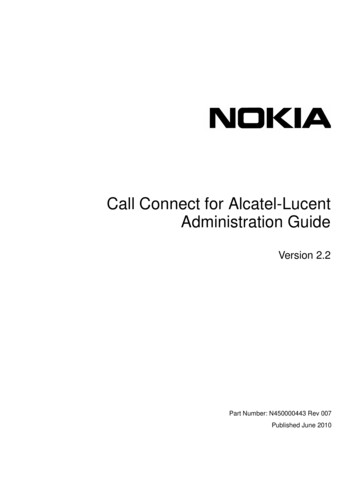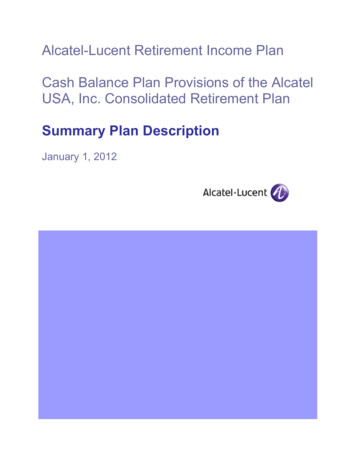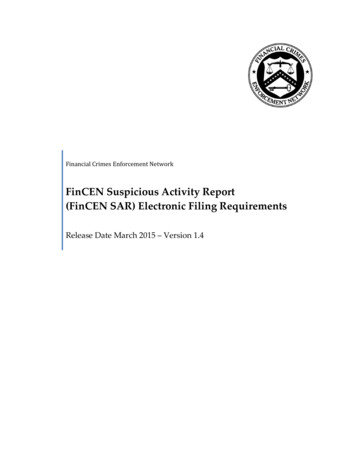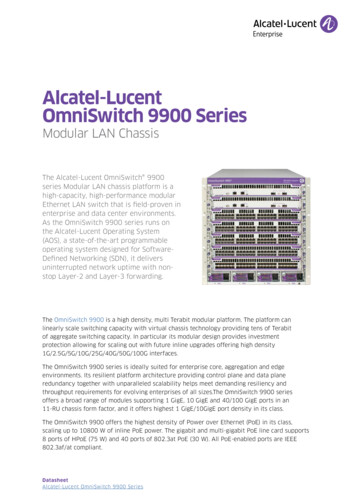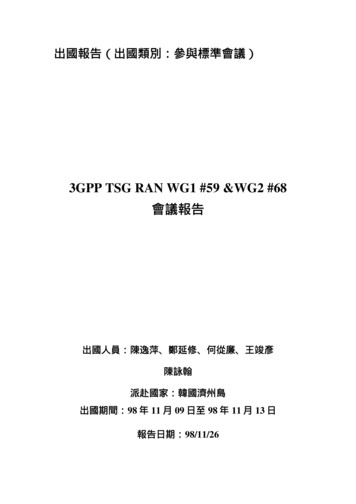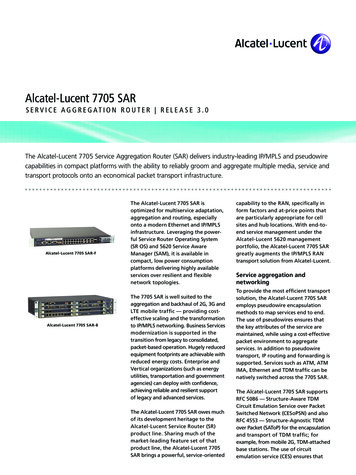
Transcription
Alcatel-Lucent 7705 SARSERV ICE AGGREG AT IO N ROU T ER REL E A SE 3.0The Alcatel-Lucent 7705 Service Aggregation Router (SAR) delivers industry-leading IP/MPLS and pseudowirecapabilities in compact platforms with the ability to reliably groom and aggregate multiple media, service andtransport protocols onto an economical packet transport infrastructure.Alcatel-Lucent 7705 SAR-FAlcatel-Lucent 7705 SAR-8The Alcatel-Lucent 7705 SAR isoptimized for multiservice adaptation,aggregation and routing, especiallyonto a modern Ethernet and IP/MPLSinfrastructure. Leveraging the powerful Service Router Operating System(SR OS) and 5620 Service AwareManager (SAM), it is available incompact, low power consumptionplatforms delivering highly availableservices over resilient and flexiblenetwork topologies.The 7705 SAR is well suited to theaggregation and backhaul of 2G, 3G andLTE mobile traffic — providing costeffective scaling and the transformationto IP/MPLS networking. Business Servicesmodernization is supported in thetransition from legacy to consolidated,packet-based operation. Hugely reducedequipment footprints are achievable withreduced energy costs. Enterprise andVertical organizations (such as energyutilities, transportation and governmentagencies) can deploy with confidence,achieving reliable and resilient supportof legacy and advanced services.The Alcatel-Lucent 7705 SAR owes muchof its development heritage to theAlcatel-Lucent Service Router (SR)product line. Sharing much of themarket-leading feature set of thatproduct line, the Alcatel-Lucent 7705SAR brings a powerful, service-orientedcapability to the RAN, specifically inform factors and at-price points thatare particularly appropriate for cellsites and hub locations. With end-toend service management under theAlcatel-Lucent 5620 managementportfolio, the Alcatel-Lucent 7705 SARgreatly augments the IP/MPLS RANtransport solution from Alcatel-Lucent.Service aggregation andnetworkingTo provide the most efficient transportsolution, the Alcatel-Lucent 7705 SARemploys pseudowire encapsulationmethods to map services end to end.The use of pseudowires ensures thatthe key attributes of the service aremaintained, while using a cost-effectivepacket environment to aggregateservices. In addition to pseudowiretransport, IP routing and forwarding issupported. Services such as ATM, ATMIMA, Ethernet and TDM traffic can benatively switched across the 7705 SAR.The Alcatel-Lucent 7705 SAR supportsRFC 5086 — Structure-Aware TDMCircuit Emulation Service over PacketSwitched Network (CESoPSN) and alsoRFC 4553 — Structure-Agnostic TDMover Packet (SAToP) for the encapsulationand transport of TDM traffic; forexample, from mobile 2G, TDM-attachedbase stations. The use of circuitemulation service (CES) ensures that
only the active time slots are transported, keeping bandwidth usage toa minimum. Also, the Alcatel-Lucent7705 SAR supports RFC 4717 — Encapsulation Methods for Transport of ATMover MPLS Networks; N:1 cell mode issupported. Multiple access ATM portsare bundled together to attain higherspeeds using IMA. The IMA protocol isterminated on the Alcatel-Lucent 7705SAR, and only the cells containing userdata that belong to a virtual circuit/virtual path (VC/VP) structure aretransported. RFC 4448 — Encapsulation Methods for Transport of Ethernetover MPLS Networks is also supported.To offer greater scalability, all thetraffic out of an Ethernet port canbe carried over a single Ethernetpseudowire or, alternatively, a pseudo wire can be created for each VLANthat is assigned to a different serviceor end-customer. IP pseudowires aresupported and provide the abilityto deterministically carry IP trafficbetween disparate media. For example,IP traffic can be carried between aPPP (or ML-PPP) access point and anEthernet connection. The 7705 SARproduct line supports BGP/MPLS VirtualPrivate Networks (VPNs) to allow theseparation of Layer 3 traffic betweendifferent groups of users or organizations. Analog voice encoding andtransport is available on the 7705SAR-8. Voiceband analog traffic canbe carried over a modern networkinfrastructure between two analogdevices using either traditional T1/E1network interfaces or over Ethernetor ML-PPP interfaces.Highly flexible network infrastructureoptions include the use of MPLS, IP orGRE (Generic Routing Encapsulation)tunneling for aggregated traffic. Whendynamic MPLS signaling is deployed,the end-to-end pseudowire is established using targeted label distributionprotocol (T-LDP) and the MPLS tunnelusing LDP. In addition to efficientLDP-based dynamic signaling, staticprovisioning of both the MPLS tunneland the pseudowire is supported.GRE or IP tunneling allows low-cost,ubiquitous IP networks to be usedfor backhauling; for example, for the2Alcatel-Lucent 7705 SAR Release 3.0 Data Sheettransport of HSPA (High Speed PacketAccess) off-loaded traffic using DSLaccess media.Label switched routingThe 7705 SAR can be configured aseither a Label Edge Router (LER) ora full Label Switched Router (LSR).Label Switched Paths (LSPs) can besignaled via either the Label Distribution Protocol (LDP) or the ResourceReservation Protocol with TrafficEngineering (RSVP-TE). The 7705 SARbrings a strong suite of traffic engineering and resiliency capabilities viafunctions such as Constraint-basedShortest Path First (CSPF) routing, FastReroute (FRR), primary and secondaryLSPs and redundant pseudowires.Quality of service and trafficmanagementIt is critical to maintain the end-to-endquality of service (QoS) for packettraffic. Not all types of traffic have thesame set of requirements. Voice trafficin particular requires low latency andjitter (latency variation) as well as lowloss, whereas data traffic often has lessstringent delay requirements but maybe very sensitive to loss, as packet losscan seriously constrain applicationthroughput. To offer the requiredtreatment throughout the network,traffic flows with different requirements are identified at the access andmarked in-line with the appropriateQoS metrics. Traffic classification andmarking are carried out based on thefollowing categories:Classification (Layer 1/Layer 2/Layer 2.5and/or Layer 3 header): Time slot/port Ethernet port/VLAN ATM service category (CBR/rt-VBR/nrt-VBR/UBR) ATM VC Ethernet 802.1p/VLAN IP DSCP/MPLS EXPMarking: Layer 2 (802.1p) Layer 2.5 (EXP) both for tunneland PWE3 Layer 3 (DiffServ)The Alcatel-Lucent 7705 SAR utilizesextensive traffic management policies toensure fairness with detailed classificationand hierarchical scheduling including:minimum/maximum, queue type-basedweighted round robin or strict priorityand profiled scheduling, as well asmulti-tier policing to differentiate andprioritize individual services and flows.Operations, administrationand maintenanceIn order to ensure continuity of services,the Alcatel-Lucent 7705 SAR has a fullset of operations, administration andmaintenance (OAM) features including: LSP ping LSP traceroute Service distribution path (SDP) ping Verifies, for example, tunnel connectivity and round trip delay Virtual circuit connectivity verification(VCCV) Verifies, for example, service levelexistence and round trip time Extends OAM to pseudowireservices Ethernet OAM functions for example: 802.3ah: Ethernet in the First Mile 802.1ag: Connectivity FaultManagement Y.1731: Ethernet OAM mechanismsfor fault management — mainlyat a service level Service Assurance Agent (SAA) Runs in background, periodicallycollecting network “health”information from OAM mechanisms(such as VCCV) and monitoring forproblems (such as SLA transgressions)These features, when under thecontrol of the Alcatel-Lucent 5620management portfolio, ensure rapidfault detection as well as efficienttroubleshooting. In particular, SLAscan be proactively monitored by theSAA. This powerful capability allowsthe specification of test suites, policiesand schedules. The tests are thenauto-created, and the results obtainedare automatically compared to predefined SLA metrics. Any transgressionsdetected are automatically reportedthrough the SAA to operations staff.
Table 1. Features and benefitsFEATURESBENEFITSCost-effective migration from E1/T1-based backhaul to economical and flexibleIP/MPLS-based transport, leveraging Ethernet or ISP network services over awide range of first mile mediaTransition from PDH-based connectivity to modern Ethernet and/or IP-basednetworking infrastructures can greatly reduce recurring operating expendituressuch as line lease costs.Resiliency and redundancy including: one-for-one hitless control and switchmodule failover (7705 SAR-8), synchronization redundancy, network uplinkresiliency and redundancy of power feeds plus temperature hardeningAdvanced resiliency features lead to improved network uptime, which canpositively impact customer retention and allow critical services to be offeredfor increased revenue.Powerful, service-aware OAM capabilities complemented by the Alcatel-Lucent5620 management portfolio for GUI-based network and element configuration,provisioning, and fault and performance managementRapid fault detection and powerful commissioning and troubleshooting toolscan improve productivity of operations staff and reduce network downtime.Dense adaptation of multiple converged services onto an efficient economicalpacket infrastructureMultiprotocol and convergence capa bilities (with flexible and granular QoS)reduce equipment instances needed to carry multiple traffic types. Compact,energy efficient platforms reduce power and cooling costs.Extends service routing IP/MPLS dynamic capabilities to the remote site, hubsand network edge in compact form factors with low power consumptionModular, flexible architecture alleviates the burden of complex pre-engineeringand future scenario planning. Compact, rugged form factors allow remote sitesto be addressed.Breadth of synchronization solutions with flexible operation, redundancyand independent validation of accuracyAccurate synchronization allows cost-effective deployment over packetinfrastructure and improves the user experience (for example, less data lossand minimal dropped calls in mobile applications).An auto-discovery protocol is supported to allow rapid commissioningof remote devices.SynchronizationCell sites rely on the backhaul networkto provide synchronous interfaces forthe proper delivery of data. In addition,cell sites may rely on the networkinterfaces as stable references withwhich to derive radio frequencies andto ensure reliable subscriber handoverbetween cell towers. Accurate synchronization is also important in wirelinenetworks in maintaining networkoperational integrity; for example,avoiding data underflows and overflows and transmission ‘slips.’The Alcatel-Lucent 7705 SAR supportsexternal reference timing, line timing,adaptive clock recovery (ACR) timing,synchronous Ethernet and also timingdistribution via 1588v2. Accuracy andhigh performance of timing overpacket solutions, such as ACR andIEEE 1588v2, are accomplished by acombination of built-in architecturalfeatures, efficiently tuned algorithmsand powerful QoS mechanisms tominimize the delay experienced bysynchronization traffic. These capabilitiesare cornerstones of the design of theAlcatel-Lucent 7705 SAR. A built-inStratum-3 clock is provided to assist insynchronization maintenance duringunavailability of a primary source.7705 SAR Family Chassis options Industry-leading scalability anddensity is provided in the 7705 SAR-8,a two rack unit (2 RU) version of the7705 SAR that supports up to 96 T1/E1Any Service, Any Port (ASAP) ports.The platform can be optionallyconfigured with a redundant controland switch module and uplinks. TheAlcatel-Lucent 7705 SAR-8 has eightslots; two are allocated for controland switch modules (CSMs), withthe remaining six being availablefor user traffic adapter cards. TheAlcatel-Lucent 7705 SAR-8 has acompact, modular architecture,constructed to allow flexible use ofline adapter cards so operators canoptimize the configuration to meetthe specific requirements of a site.With the modular architecture comesadditional resilience and flexibility.The solution can optionally support1 1 fully redundant CSMs. This industryleading, independently validatedHigh Availability feature has beeninherited from the Service Routerproduct line and is a strong contributorto overall network uptime. Each of the six adapter card slots inthe 7705 SAR-8 chassis can be usedfor any adapter card type, removingthe burden of complex pre-engineeringand future scenario planning. Theseven supported adapter cardtypes are: a 4-port OC-3/STM-1 clearchannel card, a 2-port OC-3/STM-1channelized card, a 16-port ASAPT1/E1 adapter card, an 8-port Ethernetadapter card, a 4-port DS3 card,a 6-port E&M card and a 12-portSerial Data Interface (SDI) card. The4-port OC-3/STM-1 clear channelcard supports ATM and Packet overSDH/SONET (POS) in clear channelmode with ports configurablefor SDH or SONET operation. The2-port OC-3/STM-1 channelized cardsupports ATM, inverse multiplexingover ATM (IMA) and ML-PPP withports configurable for SDH or SONEToperation. The ASAP adapter cardsupports ATM, inverse multiplexingover ATM (IMA), TDM and multiclassMLPPP. The Ethernet adapter cardhas six ports of auto-sensing 10/100Base-TX ports plus two further portssupporting 10/100/1000 Ethernet withsmall form factor pluggable (SFP)optics. The 4-port DS3 card supportsclear channel ATM and PPP access.The 6-port E&M card supports analog voice encoding and transport.The 12-port SDI card can be configuredfor RS232 or V.35 operation. Each slotis connected to the switching fabricon the CSM using a 1 Gb/s link to hostexisting and future interface types. The 7705 SAR-F is a fixed configurationversion of the Service AggregationRouter. The 7705 SAR-F is packagedin a one-rack unit (1 RU) high formfactor that supports up to 16 T1/E1Alcatel-Lucent 7705 SAR Release 3.0 Data Sheet3
Any Service, Any Port (ASAP) ports.The ASAP ports can be configuredto support ATM, inverse multiplexing over ATM (IMA), TDM andMLPPP. Six 10/100 Base-T auto-sensingEthernet ports are provided, plus twofurther ports supporting 10/100/1000Base-TX with small form factor pluggable optics (SFPs). For both chassis configurations,network uplink connectivity optionsare: Ethernet, Fast Ethernet (FE),Gigabit Ethernet (GigE), n T1/E1multi-link point-to-point protocol(MLPPP) or n T1/E1 ATM IMA.Integrated DS3 point-to-point trunking is supported via a small formfactor pluggable (SFP) device or, onthe 7705 SAR-8, via the 4-port DS3adapter card.Chassis-Dependent specificationsAlcatel-Lucent 7705 SAR-8Alcatel-Lucent 7705 SAR-FModules and adapter cardsModules and adapter cards Control and switch module (CSM) 8-port Ethernet adapter card (six ports of 10/100 Ethernet, two portsof 10/100/1000 Ethernet), DS3 point-to-point trunking is supportedvia a small form factor pluggable (SFP) device 16-port T1/E1 Any Service, Any Port (ASAP)adapter card 4-port OC-3/STM-1 clear channel adapter card 2-port OC-3/STM-1 channelized adapter card 12-port SDI (Serial Data Interface) card 4-port DS3 adapter card 6-port E&M adapter card N/A – Fixed configuration with integrated control and switch module,six ports of 10/100 Ethernet, two ports of 10/100/1000 Ethernet and16 T1/E1 Any Service, Any Port (ASAP) ports, DS3 point-to-point trunkingis supported via a small form factor pluggable (SFP) deviceRedundancy and resiliencyRedundancy and resiliency ControlFabricSynchronizationUplinksMPLS tunnelPseudowiresPower feedsCooling fansSynchronizationUplinksMPLS tunnelPseudowiresPower feedsCooling fansPhysical dimensionsPhysical dimensions Height: 2 RU, 8.9 cm (3.5 in.) Depth: 25.4 cm (10 in.) Width: 43.9 cm (17.3 in.) Rack mountable in a 48.2 cm rack, 30 cm depth(standard 19-inch equipment rack, 12-inch depth) Height: 1 RU 4.45 cm (1.75 in.) Depth: 25.4 cm (10 in.) Width: 43.9 cm (17.3 in.) Rack mountable in a 48.2 cm rack, 30 cm depth(standard 19-inch equipment rack, 12-inch depth)PowerPower Two feeds: -48/-60V DC or Two feeds: 24V DC Third-party sourced AC power solutions available: 100 – 240V AC Two feeds: -48/-60V DC or Two feeds: 24V DC Third-party sourced AC power solutions available: 100 – 240V ACCoolingCooling One tray of eight fans with redundancy Built-in 5-fan array with redundancyOperating environmentOperating environment Normal operating temperature range: -40 C to 65 C(-40 F to 149 F) sustained Normal humidity: 5% to 85% Short term (96 hours) extended humidity range:5% to 95% Normal operating temperature range:-40 C to 65 C (-40 F to 149 F) sustained Normal humidity: 5% to 95% non-condensing4Alcatel-Lucent 7705 SAR Release 3.0 Data Sheet
Service AggregationRouter specificationsServices TDM pseudowires RFC 5086 Structure-Aware TimeDivision Multiplexed (TDM)Circuit Emulation Service overPacket Switched Network(CESoPSN) RFC 4553 Structure-AgnosticTime Division Multiplexing(TDM) over Packet (SAToP) ATM pseudowires RFC 4717 Encapsulation Methodsfor Transport of AsynchronousTransfer Mode (ATM) overMPLS Networks N:1 cell mode, virtual circuitconnection and virtual pathconnection ATM IMA Ethernet pseudowires RFC 4448 Encapsulation Methods for Transport of Ethernetover MPLS Networks Raw and tagged mode MEF 9- and MEF 14-certified IP pseudowires PPP (as per RFC-1661) andML-PPP (as per RFC-1990)access to IP pseudowires Ethernet (null, tagged) accessto IP pseudowires Analog voice encoding andtransport A law, μ-law Traffic transported on aTDM pseudowire IP or MPLSinfrastructure IP VPN RFC 4364 BGP/MPLS IP VirtualPrivate Networks (VPNs)Synchronization External reference timingLine timingAdaptive timingSynchronous EthernetBuilt-in Stratum-3 clockIEEE 1588v2Synchronization Status Messages(SSMs) support for quality leveldetermination, source selectionand timing loop avoidanceTraffic management and QoS Hierarchical queuing Multi-tier scheduling Profiled (in and out of profile)scheduling Queue type-based scheduling Ingress policing and egress shaping Up to 8 queues per service Memory allocation per queue(CBS, MBS per queue) Premium, assured and best-effortforwarding classes WRED on ingress and egress Classification based on: Layer 1/Layer 2/Layer 2.5and/or Layer 3 header Timeslot/port Ethernet port/VLAN ATM service category(CBR/rt-VBRrt-VBR/UBR) ATM VC Ethernet 802.1p/VLAN IP DSCP/MPLS EXP Marking based on: Layer 2 (802.1p) Layer 2.5 (EXP) both for tunneland PWE3 Layer 3 (DiffServ)Security (node access) User ID/password-based authentication and authorization Exponential login backoff forbrute force attacks Local or remote storing ofuser information Remote authentication/authorization via Remote AuthenticationDial In User Service (RADIUS)and Terminal Access ControllerAccess-Control System (TACACS) Secure Shellv2, Secure File TransferProtocol and Simple NetworkManagement Protocol (SNMP)Version 3 Secure open interfaces Syslog Capture security logs on localor remote server Alarm on suspicious sequenceof operations Nodal attack Basic firewall with filtering ofcontrol plane traffic Denial of service (DoS) attackprevention (rate-limiting andprioritization) Data security Transfer over peer-to-peer tunnel(MPLS) MD5 authentication Sequence numbers preventreplaying of data Statistics available on suspiciousbehaviorManagement Fully-featured, industry-standardcommand line interface Service assurance tools, includingLSP ping, LSP traceroute, SDPping, VCCV ATM In-band Management SSH and Telnet FTP, Trivial File Transfer Protocoland Secure Copy Protocol RADIUS (AAA) TACACS SNMP v2/v3Safety, EMC, environmentaland telecom compliance Safety: UL/CSA 60950-1 IEC/EN 60950-1 AS/NZS 60950-1 IEC/EN 60825-1 and2 (LASER Safety) EMC: EN 55022 2006 (Class A) FCC Part 15 2008 (Class A) ICES-003 Issue 4 2004 (Class A) EN 300 386 V1.4.1 AS/NZS CISPR 22: 2006 (Class A) Telcordia GR-1089 Issue 4 RRL Notice No. 2008-38 (Class A) RRL Notice No. 2008-39 Telecom: IC CS-03 Issue 9 ACTA TIA-968-A AS/ACIF S016 (Australia/New Zealand) ITU-T G.703 ITU-T G.707 ITU-T G.712 ITU-T G.957 ITU-T V.24 ITU-T V.36 ITU-T X.21 Network Equipment and BuildingStandards (NEBS): NEBS Level 1 and 3 Telcordia GR-63-CORE, Issue 3 Telcordia GR-78-CORE, Issue 2 Telcordia GR-1089, Issue 4 ATT-TP-76200 VZ.TPR.9305 ANSI T1.315-2001 Environmental: Telcordia GR-63-CORE, Issue 3 ETSI EN 300 019-2-1 v2.1.2(Class 1.2) ETSI EN 300 019-2-2 v2.1.2(Class 2.3) ETSI EN 300 019-2-3 v2.2.2(Class 3.2) ETSI 300 132-2 v2.2.1 Directives: EU Directive 1999/5/EC R&TTE EU Directive 2002/96/EC WEEE EU Directive 2002/95/EC RoHS China: Ministry of InformationIndustry order No. 39 – CroHSStandards and protocolsStandards compliance Ethernet IEEE 802.1p/Q VLAN TaggingIEEE 802.1ag Service Layer OAMIEEE 802.3 10Base-TIEEE 802.3ah Ethernet OAMIEEE 802.3u 100Base-TXIEEE 802.3x Flow ControlIEEE 802.3z 1000Base-SX/LXITU-T Y.1731 OAM functions andmechanisms for Ethernet-basednetworksProtocol supportLDP RFC 5036 LDP SpecificationMPLS RFC 3031 Multiprotocol LabelSwitching Architecture RFC 3032 MPLS Label StackEncoding RFC 4379 Detecting MultiProtocol Label Switched (MPLS)Data Plane FailuresRSVP-TE and Fast Reroute RFC 2430 A Provider ArchitectureDiffServ and TE RFC 2702 Requirements for TrafficEngineering over MPLS RFC 2747 RSVP CryptographicAuthentication RFC 3097 RSVP CryptographicAuthentication RFC 3209 Extensions to RSVP forTunnels RFC 4090 Fast reroute extensionsto RSVP-TE for LSP TunnelsOSPF RFC 1765 OSPF DatabaseOverflow RFC 2328 OSPF Version 2 RFC 2370 Opaque LSA Support RFC 3101 OSPF NSSA Option RFC 3137 OSPF Stub RouterAdvertisement RFC 3630 Traffic Engineering (TE)Extensions to OSPF Version 2 RFC 4203 Shared Risk Link Group(SRLG) sub-TLVBGP RFC 1397 BGP Default RouteAdvertisement RFC 1997 BGP CommunitiesAttribute RFC 2385 Protection of BGPSessions via MD5 RFC 2439 BGP Route FlapDampening RFC 2547bis BGP/MPLS VPNsAlcatel-Lucent 7705 SAR Release 3.0 Data Sheet5
RFC 2918 Route RefreshCapability for BGP-4 RFC 3107 Carrying Label Information in BGP-4 RFC 3392 Capabilities Advertisement with BGP-4 RFC 4271 BGP-4 (previouslyRFC 1771) RFC 4360 BGP ExtendedCommunities Attribute RFC 4364 BGP/MPLS IP VirtualPrivate Networks (VPNs) (previously RFC 2547bis BGP/MPLSVPNs) RFC 4456 BGP Route Reflection:Alternative to Full-mesh IBGP(previously RFC 1966 and 2796) RFC 4724 Graceful RestartMechanism for BGP – GR helper RFC 4760 Multi-protocolExtensions for BGP (previouslyRFC 2858) draft-ietf-bfd-v4v6-1hop-06.txtBFD IPv4 and IPv6 (Single Hop) draft-ietf-bfd-multihop-06.txtBFD for Multi-hop PathsIS-IS RFC 791 Internet Protocol RFC 792 Internet Control MessageProtocol RFC 793 Transmission ControlProtocol RFC 826 Ethernet AddressResolution Protocol RFC 854 Telnet ProtocolSpecification RFC 1812 Requirements forIPv4 Routers RFC 1142 OSI IS-IS Intra-domainRouting Protocol (ISO 10589) RFC 1195 Use of OSI IS-IS forrouting in TCP/IP and dualenvironments RFC 2763 Dynamic HostnameExchange for IS-IS RFC 2966 Domain-wide PrefixDistribution with Two-Level IS-IS RFC 2973 IS-IS Mesh Groups RFC 3373 Three-Way Handshakefor Intermediate System to Intermediate System (IS-IS) Point-toPoint Adjacencies RFC 3567 Intermediate Systemto Intermediate System (IS-IS)Cryptographic Authentication RFC 3719 Recommendations forInteroperable Networks using IS-IS RFC 3784 Intermediate System toIntermediate System (IS-IS) Extensions for Traffic Engineering (TE) RFC 3787 Recommendations forInteroperable IP Networks RFC 4205 for Shared Risk LinkGroup (SRLG) TLV draft-ietf-isisigp-p2p-over-lan-05.txt RFC 5309 Point-to-Point Operationover LAN in Link State RoutingprotocolsBFD draft-ietf-bfd-mib-00.txt Bidirectional Forwarding DetectionManagement Information Base draft-ietf-bfd-base-05.txt Bidirectional Forwarding DetectionGRE RFC 2784 Generic RoutingEncapsulation (GRE)Differentiated services RFC 2474 Definition of the Differentiated Services Field (DS Field)in the IPv4 and IPv6 Headers RFC 2597 Assured ForwardingPHB Group RFC 2598 An Expedited Forwarding PHB RFC 3140 Per Hop BehaviorIdentification CodesTCP/IP RFC 768 User Datagram Protocol RFC 1350 The TFTP Protocol(Revision 2)PPP RFC 1332 PPP Internet ProtocolControl Protocol (IPCP) RFC 1661 The Point-to-PointProtocol (PPP) RFC 1989 PPP Link QualityMonitoring RFC 1990 The PPP MultilinkProtocol (MP)ATM RFC 2514 Definitions of TextualConventions and OBJECTIDENTITIES for ATM Management, February 1999 RFC 2515 Definition of ManagedObjects for ATM Management,February 1999 af-tm-0121.000 Traffic Management Specification Version 4.1,March 1999 ITU-T Recommendation I.610 –B-ISDN Operation and Maintenance Principles and Functionsversion 11/95 ITU-T Recommendation I.432.1 –B-ISDN user-network interface –Physical layer specification:General characteristics GR-1248-CORE – Generic Require ments for Operations of ATMNetwork Elements (NEs), Issue 3,June 1996 GR-1113-CORE – AsynchronousTransfer Mode (ATM) AdaptationLayer (AAL) Protocols GenericRequirements, Issue 1, July 1994Pseudowires RFC 4385 Pseudowire EmulationEdge-to-Edge (PWE3) ControlWord for Use over an MPLS PSN RFC 4447 Pseudowire Setup andMaintenance using the LabelDistribution Protocol (LDP) RFC 4448 Encapsulation Methodsfor Transport of Ethernet overMPLS Networks RFC 4553 Structure-AgnosticTime Division Multiplexing (TDM)over Packet (SAToP) RFC 4717 Encapsulation Methodsfor Transport of AsynchronousTransfer Mode (ATM) over MPLSNetworks RFC 5085 Pseudowire VirtualCircuit Connectivity Verification(VCCV): A Control Channel forPseudowires RFC 5086 Structure-Aware TimeDivision Multiplexed (TDM) CircuitEmulation Service over PacketSwitched Network (CESoPSN)RADIUS RFC 2865 Remote AuthenticationDial In User Service (RADIUS) RFC 2866 RADIUS AccountingSSH draft-ietf-secsh-architecture.txtSSH Protocol Architecture draft-ietf-secsh-userauth.txt SSHAuthentication Protocol draft-ietf-secsh-transport.txt SSHTransport Layer Protocol draft-ietf-secsh-connection.txtSSH Connection Protocol draft-ietf-secsh-newmodes.txtSSH Transport Layer EncryptionModesTACACS IETF draft-grant-tacacs-02.txt ITU-T X.734: Informationtechnology-OSI-Systems Management: Event Report ManagementFunction M.3100/3120 Equipment andConnection Models TMF 509/613 Network ConnectivityModel RFC 1157 SNMPv1 RFC 1907 SNMPv2-MIB RFC 2011 IP-MIB RFC 2012 TCP-MIB RFC 2013 UDP-MIB RFC 2138 RADIUS RFC 2571 SNMP-Framework-MIB RFC 2572 SNMP-MPD-MIB RFC 2573 SNMP-Applications RFC 2574 SNMP-User-BasedSM-MIB RFC 2575 SNMP-View-BasedACM-MIB RFC 2576 SNMP-COMMUNITYMIB RFC 2665 Ethernet-like-MIB RFC 2819 RMON-MIB RFC 2863 The InterfacesGroup-MIB RFC 2864 Inverted-Stack-MIB RFC 3014 Notification-Log-MIB RFC 3273 HCRMON-MIB RFC 3411 An Architecture forDescribing Simple NetworkManagement Protocol (SNMP)Management Frameworks RFC 3412 Message Processingand Dispatching for the SimpleNetwork Management Protocol(SNMP) RFC 3413 Simple NetworkManagement Protocol (SNMP)Applications RFC 3414 User-based SecurityModel (USM) for version 3 of theSimple Network ManagementProtocol (SNMPv3) RFC 3418 SNMP MIB draft-ietf-disman-alarm-mib-04.txt draft-ietf-mpls-ldp-mib-07.txt IANA-ifType-MIBPlus support for an extensive rangeof proprietary MIBs.Network management ITU-T X.721: Informationtechnology-OSI-Structure ofManagement Informationwww.alcatel-lucent.comAlcatel, Lucent, Alcatel-Lucent and the Alcatel-Lucent logoare trademarks of Alcatel-Lucent. All other trademarks are the property of their respective owners.The information presented is subject to change without notice. Alcatel-Lucent assumes no responsibilityfor inaccuracies contained herein. Copyright 2010 Alcatel-Lucent. All rights reserved.CPG2896091201 (01)
SDH/SONET (POS) in clear channel mode with ports configurable for SDH or SONET operation. The 2-port OC-3/STM-1 channelized card supports ATM, inverse multiplexing over ATM (IMA) and ML-PPP with ports configurable for SDH or SONET operation. The ASAP adapter card supports ATM, inverse multiplexing over ATM (IMA), TDM and multiclass MLPPP.
